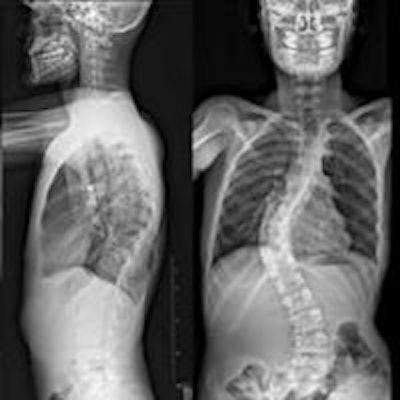
Biplanar low-dose x-ray systems outperform standard digital radiography (DR) systems in terms of delivering a lower radiation dose to the patient and expediency in acquiring images, but their cost and limited uses require high examination volume to make them cost-effective, Swiss researchers believe.
These findings were identified in a study of the two systems that compared radiation dose delivered to a patient, the comfort of a patient having an examination, and the workflow efficiency in performing. Radiologists at the Orthopedic University Hospital Balgrist in Zurich also performed a cost analysis published online on 28 March in Skeletal Radiology.
 Neutral standing radiographs of 18-year-old man demonstrates dextroscoliosis at the thoracic level (Cobb angle: 65°) and levoscoliosis at the lumbar level (Cobb angle: 55°). Standard digital radiographs on the left side were obtained at the first consultation. Biplanar radiographs on the right side were requested six weeks later prior to surgery. Additional secondary 3D reconstructions of the biplanar radiographs were provided to the spine surgeon to plan the operation. All images courtesy of Dr. Tobias Dietrich.
Neutral standing radiographs of 18-year-old man demonstrates dextroscoliosis at the thoracic level (Cobb angle: 65°) and levoscoliosis at the lumbar level (Cobb angle: 55°). Standard digital radiographs on the left side were obtained at the first consultation. Biplanar radiographs on the right side were requested six weeks later prior to surgery. Additional secondary 3D reconstructions of the biplanar radiographs were provided to the spine surgeon to plan the operation. All images courtesy of Dr. Tobias Dietrich.This cost analysis may prove useful for imaging departments considering purchasing a biplanar x-ray unit (EOS Imaging), according to lead author Dr. Tobias J. Dietrich and colleagues.
Biplanar x-ray systems are used to image patients with musculoskeletal deformities. Unlike standard x-ray systems, they acquire whole body radiographs without distortions. It is also possible to perform secondary 3D reconstructions with measurement of both internal and external surfaces without the need to acquire multiple tomographic images.
The Swiss study included the acquisition of 68 consecutive anteroposterior (AP) full-length, lower-limb radiographs and 47 consecutive AP and lateral whole-spine radiographs acquired using a standard digital radiography system (Ysio, Siemens Healthcare). Additionally, 198 AP full-length, lower-limb radiographs and 134 AP and lateral whole-spine radiographs were acquired from the biplanar x-ray system. All radiographs were obtained of patients who were standing in an upright position and who were comparable in height and weight for each group.
Because of its design, the biplanar x-ray system enables diagnostic quality images to be acquired at lower radiation levels. As a result, the dose area product was lower than that of the standard DR system. A whole spine image generated a dose area product of 158.4 cGy/cm2 compared with 392.2 cGy/cm2 when a standard DR system was used.
For the most part, patients ranked the comfort level of the two systems similarly. However, patients having a full-length lower limb radiography exam said they felt more claustrophobic in the biplanar x-ray system than in a standard DR system.
 "We are convinced that the results of our study will help investment decisions," Dr. Tobias J. Dietrich said.
"We are convinced that the results of our study will help investment decisions," Dr. Tobias J. Dietrich said.
To determine the maximum number of examinations each system could handle if fully scheduled, researchers recorded the amount of time an exam took for each unit on three fully scheduled days. They considered that an exam began when a technologist greeted a patient in the waiting room -- before the patient left the changing room and was escorted back to the radiology department's reception area, because this was the procedure used at the Orthopedic University Hospital.
If time activation had been when a patient entered the imaging suite and the ending time was the departure time of the patient from the imaging suite, the time allocated for the exam would have been shorter.
Over the three-day measurement period, an average of 48 exams was performed each day with the standard DR unit compared with 69 exams for the biplanar unit. Extrapolating this data, the researchers theorized the standard DR unit could process 12,000 exams, and the biplanar unit could process 17,250 exams during a 250-workday year.
The average reimbursement for an exam using either system was 182 Swiss francs (150 euros).The acquisition cost of the standard DR system was 88,700 Swiss francs (73,047 euros) and 160,500 Swiss francs (132,167 euros). After calculating fixed and variable costs, the authors determined at their hospital the financial break-even point would be 2,602 radiographs per year for the standard DR x-ray system and 4,077 radiographs per year for the biplanar low-dose x-ray system.
Based on their cost analysis, Dietrich and colleagues concluded a biplanar x-ray system can be operated cost-effectively in addition to a standard DR radiography system in hospitals that perform a high number of exams of patients requiring whole body or full-length, lower-limb radiographs.
In email communication with AuntMinnieEurope.com, Dietrich advised that novel biplanar x-ray scanners have been commercially available for several years, but no assessment had been made as to whether they were an appropriate modality investment for a hospital.
The results of their study will help investment decisions, as well as aid radiologists in understanding the benefits and disadvantages of biplanar x-ray systems in daily clinical work, the authors said.



















